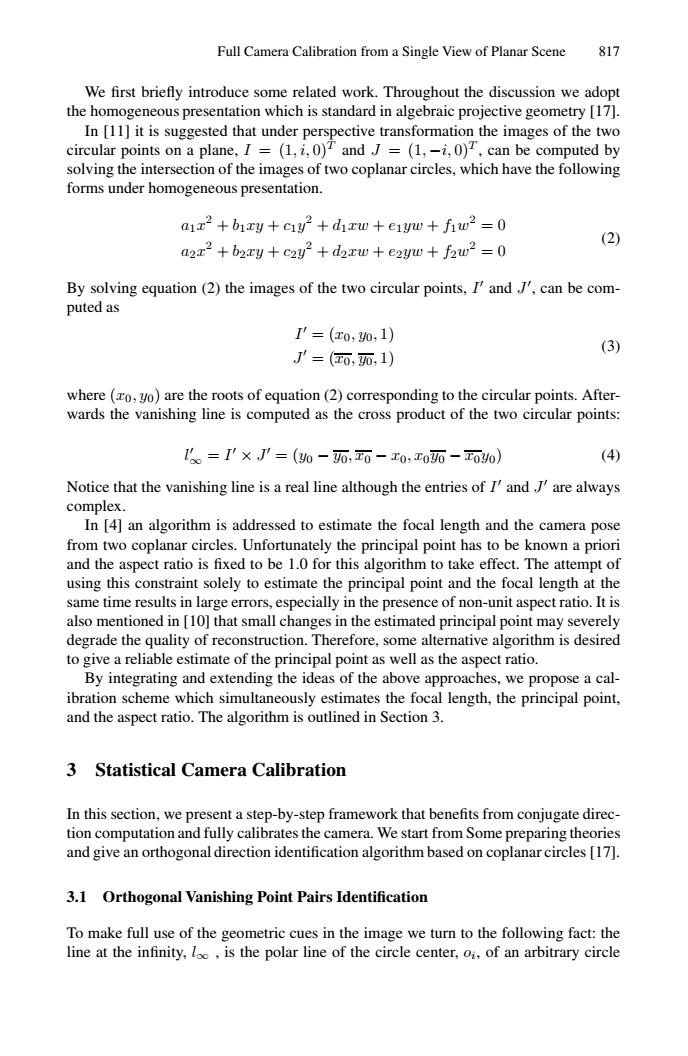正在加载图片...

Full Camera Calibration from a Single View of Planar Scene 817 We first briefly introduce some related work.Throughout the discussion we adopt the homogeneous presentation which is standard in algebraic projective geometry |171. In [11]it is suggested that under perspective transformation the images of the two circular points on a plane.I (1,i,0)and J=(1.-i,0)".can be computed by solving the intersection of the images of two coplanar circles,which have the following forms under homogencous presentation. anx2+ory+cry?+dirw +ery+fu2=0 (2) 2x2+b2y+c22+d2x+2m+f2r2=0 By solving equation (2)the images of the two circular points,I'and',can be com- puted as P=(r0,%,1) '=6,死1) (3) where (o.o)are the roots of equation (2)corresponding to the circular points.After- wards the vanishing line is computed as the cross product of the two circular points: =T×'=(h一而,石-0,0所-0) (4) Notice that the vanishing line is a real line although the entries of /and J are always complex. In [4]an algorithm is addressed to estimate the focal length and the camera pose from two coplanar circles.Unfortunately the principal point has to be known a priori and the aspect ratio is fixed to be 1.0 for this algorithm to take effect.The attempt of using this constraint solely to estimate the principal point and the focal length at the same time results in large errors,especially in the presence of non-unit aspect ratio.It is also mentioned in 10]that small changes in the estimated principal point may severely degrade the quality of reconstruction.Therefore,some alterative algorithm is desired to give a reliable estimate of the principal point as well as the aspect ratio. By integrating and extending the ideas of the above approaches,we propose a cal- ibration scheme which simultancously estimates the focal length,the principal point, and the aspect ratio.The algorithm is outlined in Section 3. 3 Statistical Camera Calibration In this section,we present a step-by-step framework that benefits from conjugate direc- tion computation and fully calibrates the camera We start from Some preparing theories and give an orthogonal direction identification algorithm based on coplanar circles |17]. 3.1 Orthogonal Vanishing Point Pairs Identification To make full use of the geometric cues in the image we tum to the following fact:the line at the infinity,lc,is the polar line of the cirele center,o of an arbitrary circle Full Camera Calibration from a Single View of Planar Scene 817 We first briefly introduce some related work. Throughout the discussion we adopt the homogeneous presentation which is standard in algebraic projective geometry [17]. In [11] it is suggested that under perspective transformation the images of the two circular points on a plane, I = (1,i, 0)T and J = (1, −i, 0)T , can be computed by solving the intersection of the images of two coplanar circles, which have the following forms under homogeneous presentation. a1x2 + b1xy + c1y2 + d1xw + e1yw + f1w2 = 0 a2x2 + b2xy + c2y2 + d2xw + e2yw + f2w2 = 0 (2) By solving equation (2) the images of the two circular points, I and J , can be computed as I = (x0, y0, 1) J = (x0, y0, 1) (3) where (x0, y0) are the roots of equation (2) corresponding to the circular points. Afterwards the vanishing line is computed as the cross product of the two circular points: l ∞ = I × J = (y0 − y0, x0 − x0, x0y0 − x0y0) (4) Notice that the vanishing line is a real line although the entries of I and J are always complex. In [4] an algorithm is addressed to estimate the focal length and the camera pose from two coplanar circles. Unfortunately the principal point has to be known a priori and the aspect ratio is fixed to be 1.0 for this algorithm to take effect. The attempt of using this constraint solely to estimate the principal point and the focal length at the same time results in large errors, especially in the presence of non-unit aspect ratio. It is also mentioned in [10] that small changes in the estimated principal point may severely degrade the quality of reconstruction. Therefore, some alternative algorithm is desired to give a reliable estimate of the principal point as well as the aspect ratio. By integrating and extending the ideas of the above approaches, we propose a calibration scheme which simultaneously estimates the focal length, the principal point, and the aspect ratio. The algorithm is outlined in Section 3. 3 Statistical Camera Calibration In this section, we present a step-by-step framework that benefits from conjugate direction computation and fully calibrates the camera. We start from Some preparing theories and give an orthogonal direction identification algorithm based on coplanar circles [17]. 3.1 Orthogonal Vanishing Point Pairs Identification To make full use of the geometric cues in the image we turn to the following fact: the line at the infinity, l∞ , is the polar line of the circle center, oi, of an arbitrary circle���������